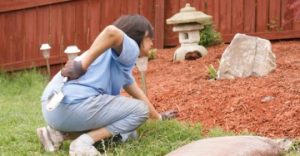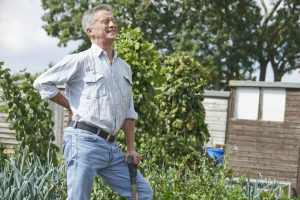Spring is coming (no, it really is, honestly!) and for many of us that means the chance to get back out in the garden. As a chiropractor, I recommend gardening as a relaxing way to connect with nature and find some peace, but also as a great form of enjoyable exercise – which can actually be highly beneficial for the spine! What’s also great is that research shows that gardening not only relieves stress, but it may also ward off emotional problems like depression.[1] There’s one common downside the gardening however – backache! Today, lets take a look at how to avoid some common gardening tweaks and strains so you can enjoy the outdoors pain free!
Gardening is hard work
For many people there’s just nothing more enjoyable than sitting back and enjoying watching your garden grow – weather you’re a home grower or flower enthusiast though, great gardens take hard work and preparation! Raking, weeding and planting seeds on hands and knees are just a few of the garden-related activities that commonly bring on back pain.
Specifically, these repetitive activities are linked with a spinal disorder called vertebral subluxation. This common condition occurs when spinal movement is restricted or spinal bones (vertebrae) become misaligned . Vertebral subluxations are linked with a myriad of health concerns, such as backache, carpal tunnel syndrome & headaches. Chiropractic care is specifically targeted to correct and prevent vertebral subluxation – but lets look at some ways you can help to prevent it!
Quit twisting!
Gardening activities such as raking, hoeing, shoveling, weeding and digging are hard on the back because they require constant twisting and turning – excessive twisting and turning isn’t great for the spine. You can actually reduce your risk of gardening strain or injury just by cutting down on this twisting and turning, especially when holding a heavy tool – try putting your wheelbarrow directly in front of you, or as close to your side as possible to avoid excessive turning. You might be surprised how effective this simple tip can be!
Have a warm up
Gardening is great exercise, and we should think of it that way! Just like any other workout, a proper warm -up is vital to staving off injury. Just five to ten minutes of stretching before gardening can make a huge difference when it comes to preventing strains and sprains. This is especially true if you’re older, or are recovering from an injury, but the benefits of stretching apply to everyone!
Don’t pop up!
Avoid the Dreaded “Pop Up” wherever possible – When using tools with long handles, such a rakes, hoes and shovels, prop them up against the side of the house or o tree when not in use. This will prevent gardeners from accidentally stepping on the tool and receiving a (possibly comical.) slap in the face. More likely, stepping on a tool will result in a trip or fall, and a possible spinal injury.
Shovel carefully
Shovelling exacts a greater toll on the muscles of your back than any other gardening task. To avoid injury , never overload the shovel, especially when transporting heavy material such as soil or sand. Instead, lift only small, manageable amounts. Bend your knees slightly, as you dig into the dirt, and lift with your legs -not your back. This is really just an extension of the good lifting technique we teach all the time – but be careful not to fall into bad habits when doing different tasks!
Stay sharp – stay safe…
Everyone knowns that sharp tools, such as hedge and gross clippers can be accidents waiting to happen. However, tools which are too blunt can also be a problem – blunt tools force your body to work harder, often in a way which it isn’t best designed to do. For this reason, its better to keep sharp tools sharp and then find ways to make them safe when not in use. High shelves, a locked shed, or even blade covers (which you can easily make yourself!) are better ways to protect children in the garden.
Pace Yourself
After months of being stuck inside, its easy to understand why we rush outside at the first glimmer of sunlight, ready to take on a myriad of garden projects. We love the enthusiasm, but this year try starting with some smaller projects to ease yourself back into the tasks involved in gardening. This gives your body a chance to catch up and adapt.
If you’re a very ken gardener, consider some targeted exercise during the winter, to keep you supple, strong and ready to hit the garden when spring next rolls around.
Grab some spine friendly garden supplies!
If you suffer with back pain (or if you just want to avoid it) consider making an investment in some back friendly equipment. Lightweight shovels also lighten the load on backs and knees. Instead of bending over to prune your petunias, how about kneeling in comfort on a colourful mini-mat. Or choose the deluxe model that comes with side railings – perfect to help push yourself back up afterwards! A small garden cutting container can help reduce the load by allowing you to transport rubbish to your garden bin in manageable loads, rather than lugging the large bin around.
Be sun smart

In countries with lots of sun, like Australia and in some of the US states, kids are taught the importance of being “sun smart” right from an early age. In the UK, sunburn is an often-overlooked health hazard of gardening – its understandable given the weather we get for much of the year, but sunburn is serious, as anyone who has suffered its scorching effects – or developed skin cancer from overexposure will tell you. You probably take care in the sun when you go abroad, and you should do so at home too!
If you’re out in the sun, wear a shirt and hat – or at least factor 50 sunscreen. Choose natural sunscreen if possible, to avoid toxic chemicals. Preventing sunburn in children is particularly important. Epidemiological studies have shown that excessive sun exposure received during childhood may increase the risk of developing skin cancer later in life.”[2]
To guard against sunstroke, also known as heatstroke, wear a hat when gardening and avoid working outside during the hottest part of the day. This is particularly important for young children and the elderly. Symptoms of overexposure to sun and heat include sweating, headache, elevated body temperature, mental confusion , irregular heart rhythms and unconsciousness.
Gardening injuries happen, don’t panic
At the end of the day, no matter how careful you are gardening injuries do happen. If you find yourself experiencing back, neck or shoulder pain after gardening it’s highly likely you’ve sustained a small injury. Small injuries are rarely a problem, and with proper care often resolve in just a few days.
DONT let a small injury become a more serious one by ignoring the problem, covering it up with painkillers and carrying on. Pop down to Complete Chiropractic and let out team give you a spine MOT! Sometimes injuries are just bad luck, in which case some supportive care and proper stretches will help you recover faster, but its also common for underlying subluxations to elevate your risk of injury. A few adjustments could see you out in the garden all season, rather than stuck on the couch in pain!
[1] Tufts University Health & Nutrition letter 2000;18:3
[2] Health Educ Res 2003 ;18:58- 73.



